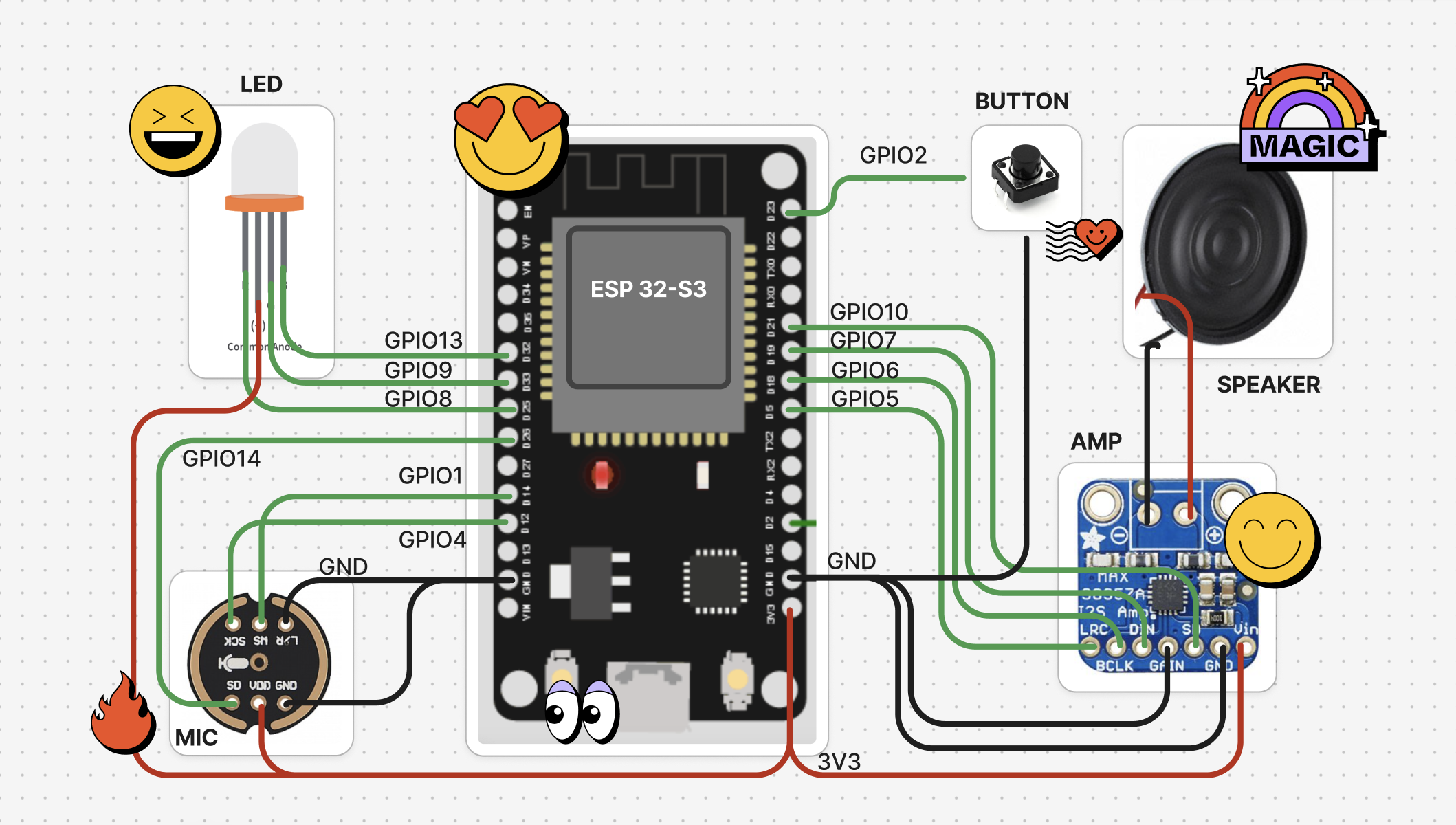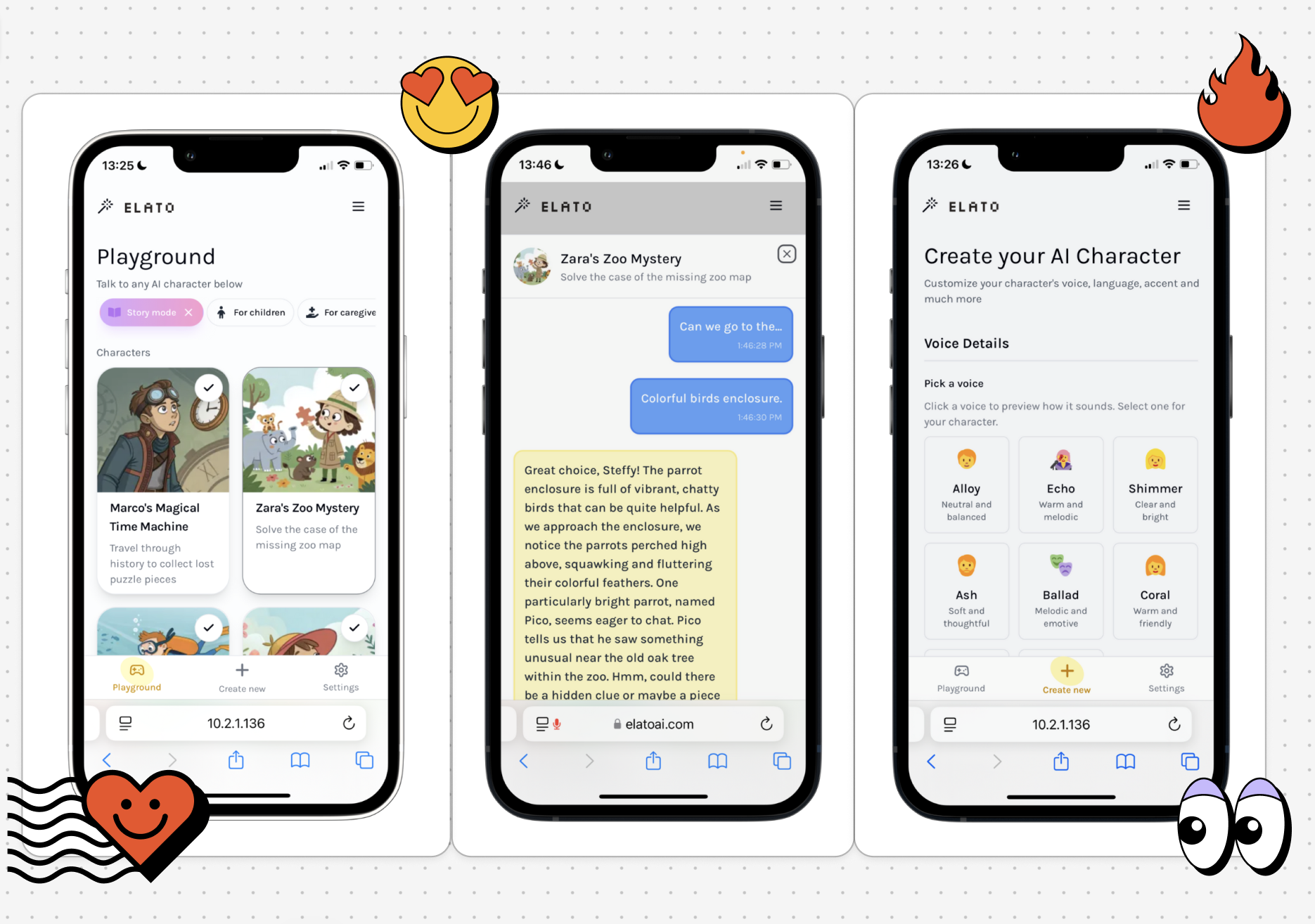
This guide shows how to build a AI voice agent device with Realtime AI Speech powered by OpenAI Realtime API, ESP32, Secure WebSockets, and Deno Edge Functions for >10-minute uninterrupted global conversations.
An active version of this README is available at ElatoAI.
⚡️ DIY Hardware Design
The reference implementation uses an ESP32-S3 microcontroller with minimal additional components:

Required Components:
- ESP32-S3 development board
- I2S microphone (e.g., INMP441)
- I2S amplifier and speaker (e.g., MAX98357A)
- Push button to start/stop the conversation
- RGB LED for visual feedback
- Optional: touch sensor for alternative control
Hardware options: A fully assembled PCB and device is available in the ElatoAI store.
📱 App Design
Control your ESP32 AI device from your phone with your own webapp.

| Select from a list of AI characters | Talk to your AI with real-time responses | Create personalized AI characters |
|---|
✨ Quick Start Tutorial

- Clone the repository
Head over to the ElatoAI GitHub repository and clone the repository.
git clone https://github.com/akdeb/ElatoAI.git
cd ElatoAI- Set your environment variables (OPENAI_API_KEY, SUPABASE_ANON_KEY)
In the frontend-nextjs directory, create a .env.local file and set your environment variables.
cd frontend-nextjs
cp .env.example .env.local
# In .env.local, set your environment variables
# NEXT_PUBLIC_SUPABASE_ANON_KEY=<your-supabase-anon-key>
# OPENAI_API_KEY=<your-openai-api-key>In the server-deno directory, create a .env file and set your environment variables.
cd server-deno
cp .env.example .env
# In .env, set your environment variables
# SUPABASE_KEY=<your-supabase-anon-key>
# OPENAI_API_KEY=<your-openai-api-key>- Start Supabase
Install Supabase CLI and set up your Local Supabase Backend. From the root directory, run:
brew install supabase/tap/supabase
supabase start # Starts your local Supabase server with the default migrations and seed data.- Set up your NextJS Frontend
From the frontend-nextjs directory, run the following commands. (Login creds: Email: admin@elatoai.com, Password: admin)
cd frontend-nextjs
npm install
# Run the development server
npm run dev- Start the Deno server
# Navigate to the server directory
cd server-deno
# Run the server at port 8000
deno run -A --env-file=.env main.ts- Setup the ESP32 Device firmware
In Config.cpp set ws_server and backend_server to your local IP address. Run ifconfig in your console and find en0 -> inet -> 192.168.1.100 (it may be different for your Wifi network). This tells the ESP32 device to connect to your NextJS frontend and Deno server running on your local machine. All services should be on the same Wifi network.
- Setup the ESP32 Device Wifi
Build and upload the firmware to your ESP32 device. The ESP32 should open an ELATO-DEVICE captive portal to connect to Wifi. Connect to it and go to http://192.168.4.1 to configure the device wifi.
-
Once your Wifi credentials are configured, turn the device OFF and ON again and it should connect to your Wifi and your server.
-
Now you can talk to your AI Character!
🚀 Ready to Launch?
- Register your device by adding your ESP32 Device's MAC Address and a unique user code to the
devicestable in Supabase.
Pro Tip: To find your ESP32-S3 Device's MAC Address, build and upload
test/print_mac_address_test.cppusing PlatformIO and view the serial monitor.
-
On your frontend client in the Settings page, add the unique user code so that the device is linked to your account in Supabase.
-
If you're testing locally, you can keep enabled the
DEV_MODEmacro infirmware-arduino/Config.hand the Deno server env variable to use your local IP addresses for testing. -
Now you can register multiple devices to your account by repeating the process above.
Project Architecture
ElatoAI consists of three main components:
- Frontend Client (
Next.jshosted on Vercel) - to create and talk to your AI agents and 'send' it to your ESP32 device - Edge Server Functions (
Denorunning on Deno/Supabase Edge) - to handle the websocket connections from the ESP32 device and the OpenAI API calls - ESP32 IoT Client (
PlatformIO/Arduino) - to receive the websocket connections from the Edge Server Functions and send audio to the OpenAI API via the Deno edge server.
🌟 Key Features
- Realtime Speech-to-Speech: Instant speech conversion powered by OpenAI's Realtime APIs.
- Create Custom AI Agents: Create custom agents with different personalities and voices.
- Customizable Voices: Choose from a variety of voices and personalities.
- Secure WebSockets: Reliable, encrypted WebSocket communication.
- Server VAD Turn Detection: Intelligent conversation flow handling for smooth interactions.
- Opus Audio Compression: High-quality audio streaming with minimal bandwidth.
- Global Edge Performance: Low latency Deno Edge Functions ensuring seamless global conversations.
- ESP32 Arduino Framework: Optimized and easy-to-use hardware integration.
- Conversation History: View your conversation history.
- Device Management and Authentication: Register and manage your devices.
- User Authentication: Secure user authentication and authorization.
- Conversations with WebRTC and Websockets: Talk to your AI with WebRTC on the NextJS webapp and with websockets on the ESP32.
- Volume Control: Control the volume of the ESP32 speaker from the NextJS webapp.
- Realtime Transcripts: The realtime transcripts of your conversations are stored in the Supabase DB.
- OTA Updates: Over the Air Updates for the ESP32 firmware.
- Wifi Management with captive portal: Connect to your Wifi network from the ESP32 device.
- Factory Reset: Factory reset the ESP32 device from the NextJS webapp.
- Button and Touch Support: Use the button OR touch sensor to control the ESP32 device.
- No PSRAM Required: The ESP32 device does not require PSRAM to run the speech to speech AI.
- OAuth for Web client: OAuth for your users to manage their AI characters and devices.
🛠 Tech Stack
| Component | Technology Used |
|---|---|
| Frontend | Next.js, Vercel |
| Backend | Supabase DB |
| Edge Functions | Edge Functions on Deno / Supabase Edge Runtime |
| IoT Client | PlatformIO, Arduino Framework, ESP32-S3 |
| Audio Codec | Opus |
| Communication | Secure WebSockets |
| Libraries | ArduinoJson, WebSockets, AsyncWebServer, ESP32_Button, Arduino Audio Tools, ArduinoLibOpus |
📈 Core Use Cases
We have a Usecases.md file that outlines the core use cases for the Elato AI device or any other custom conversational AI device.
🗺️ High-Level Flow

Project Structure

⚙️ PlatformIO Config
[env:esp32-s3-devkitc-1]
platform = espressif32 @ 6.10.0
board = esp32-s3-devkitc-1
framework = arduino
monitor_speed = 115200
lib_deps =
bblanchon/ArduinoJson@^7.1.0
links2004/WebSockets@^2.4.1
ESP32Async/ESPAsyncWebServer@^3.7.6
https://github.com/esp-arduino-libs/ESP32_Button.git#v0.0.1
https://github.com/pschatzmann/arduino-audio-tools.git#v1.0.1
https://github.com/pschatzmann/arduino-libopus.git#a1.1.0📊 Important Stats
- ⚡️ Latency: <2s round-trip globally
- 🎧 Audio Quality: Opus codec at bitrate 12kbps (high clarity)
- ⏳ Uninterrupted Conversations: Up to 10 minutes continuous conversations
- 🌎 Global Availability: Optimized with edge computing with Deno
🛡 Security
- Secure WebSockets (WSS) for encrypted data transfers
- Optional: API Key encryption with 256-bit AES
- Supabase DB for secure authentication
- Supabase RLS for all tables
🚫 Limitations
- 3-4s Cold start time while connecting to edge server
- Limited to upto 10 minutes of uninterrupted conversations
- Edge server stops when wall clock time is exceeded
- No speech interruption detection on ESP32
License
This project is licensed under the MIT License - see the LICENSE file for details.
This example is part of the OpenAI Cookbook. For the full project and latest updates, check out ElatoAI and consider giving it a ⭐️ if you find it useful!
